July, 11-13th 2018, Graz University of Technology, Petersgasse 16, 8010 Graz, Austria
Introduction
In the second week of July, the workshop Interfacing Machine Learning and Experimental Methods for Surface Structures (IMPRESS) was held at the TU Graz. The advent of machine learning methods has drastically changed the way structure determination is performed, since it facilitates the rational design of (new) experiments and the analysis of large amounts of data. The target of the workshop was to bring experimentalists and theorists together, so that both can learn and benefit from each other’s expertise. About 50 scientists from Asia, America, and Europe followed the call, making the workshop, which was sponsored by CECAM and the Psi-k, a great success.
Programme
The participants gathered at the Insitute of Solid State Physikcs for morning coffee at 9am on every morning of the event. On Wednesday (Juny 11), Oliver Hofmann from TU Graz welcomed everyone and introduced the daily format of interchanging invited talk, contributed talk and discussion sessions.
After Alexander Hinderhofer (Univ. Tübingen) opened the event with a talk on monitoring growth of thin films experimentally, Chiara Panosetti (TU Munich) and Katrin Forster-Tonigold presented „tradiational“ approaches to computationally find surface or interface geometries. After the coffe break, Milica Torodović (Aalto) and Andreas Jeindl (TU Graz) introduced their respective machine learning approaches for surface structure search.
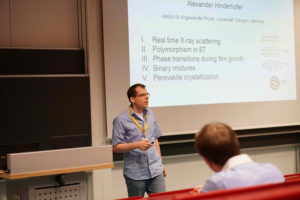
Conversations continued over lunch and through the 2h discussion session. The last session of Wednesday addressed kinetics at the interface: Peter Zeppenfeld (JKU Linz) discussed thermodynamics and the importance of transition states for the dynamics of polymorph formation. Afterwards, Daniel Packwood (Kyoto University) introduced an Bayes‘ Learning approach to obtain the parameters necessary for kinetic Monte-Carlo simulation. The last talk of that day was given by Roland Resel (TU Graz), who presented x-ray diffraction results to follow the polymorphism of thin films experimentally. The programme ended with a busy poster session, where diverse new structure search techniques were discussed over wine, beer, and local pastries.
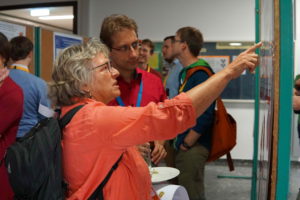
On Thursday (July 12) the invited talks focused on interfaces and boundaries with Torsten Fritz (Univ. Jena), Tim Frolov (LLNW) and Antti Karttunen (Aalto). The topic continued in the contributed session, with, Julian Pilz (TU Graz) presenting experimental challenges in substrate and parameter control, and Benedikt Hartl (TU Vienna) providing an overview over the problems at interfaces under electrochemical control. After another intense 2h discussion session, three more invited talks highlighted the challenge of structure-to-structure relationships, with experimental viewpoints presented by Daniel Wegner (The Netherlands) and Takanori Fukushima (Tokio Institute of Technology) and the computational counterpart by Talat Rahman (Univ. Florida). In the evening, the workshop participants met for the conference dinner at the Hotel Weitzer, where local Austrian food was served.
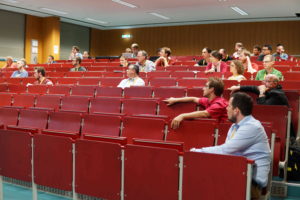
The closing invited talk of the workshop on Friday, July 13, was given by Bernd Meyer (FAU Erlangen-Nürnberg) with recent advances in methodology to predict the structure at solid/liquid interfaces. After another round of discussion sessions, the workshop was closed with contributed talks by Turner and Hinuma. The workshop was closed closed at midday by Milica Todorović with a summary oft he topics discussed and the topics still open.
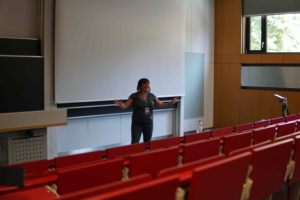
Financial support from Psi-K and CECAM allowed us to bring together almost 50 participants from three continents (Europe, North Amerika, and Asia). It enabled us to keep the event free of registration costs to encourage the participation of younger researchers.
Discussions
Despite the recent breathtaking advances in both computational and experimental methods, there is still a notable lack of understanding what the respecitvie communities can do for each other. Each day, the participants gathered in a large meeting room to brainstorm and exchange ideas, concepts, and problems. The panel at each table was hosted by an invited speaker on a key topic of their own choice: these were advertised in advance to allow participants to join several panels. Fresh fruit, coffee and sweets were served throughout. All participants contributed thoughts and conclusions to the online questionnaire tool (Presemo) for each discussion table.
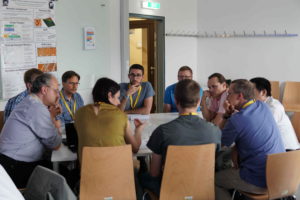
The online tool allowed us to summarise the conclusion from the discussion sessions. One of the main outcomes was, perhaps, that machine learning has contributed a lot to copmutational methods, but has not fully arrived at experimental tools, where it would have the potential to speed up, and better plan, measurement campaings. A further concern raised multiple times throughout the discussions was whether – or to what extend – machine learning is merely a correlation analysis, or can provided true scientific insight.
Workshop links
IMPRESS website | Abstract book
List of Invited Talks
- A. Hinderhofer (University of Tübingen, Germany): FOLLOWING MOLECULAR THIN FILM STRUCTURE FORMATION IN REAL- TIME BY X-RAY SCATTERING
- C. Panosetti (Technische Universität München): BETTER (RANDOM)WALKING THROUGH CHEMISTRY: HOW NOT TO GET LOST IN VAST CONFIGURATIONAL SPACES
- K. Forster-Tonigold (Ulm University, Germany): INTERACTIONS OF IONIC LIQUIDS AT (SEMI)METAL SURFACES
- P. Zeppenfeld (Johannes Kepler University Linz, Austria): ADSORPTION, CONDENSATION AND DESORPTION OF ATOMS AND MOLECULES ON SURFACES
- D. M. Packwood (Kyoto University): INFORMATICS FOR SURFACE-ASSISTED MOLECULAR SELFASSEMBLY AND NANOSTRUCTURE PREDICTION
- R. Resel (TU Graz): EPITAXIAL ORDER OF 3-DIMENSIONAL ORGANIC CRYSTALS: THE CASE OF ROD-LIKE CONJUGATED MOLECULES
- T. Fritz (Friedrich-Schiller-Universität Jena, Germany): EPITAXY WITHOUT COINCIDENCES – THE STABILIZING ROLE OF STATIC DISTORTION WAVES
- T. Frolov (Lawarence Livermore National Labs, USA): MODELING TRANSITIONS AT GRAIN BOUNDARIES
- A. J. Karttunen (Aalto University, Finland): EVOLUTIONARY STRUCTURE PREDICTION FOR MAGNETIC INORGANIC – ORGANIC COORDINATION POLYMERS
- D. Wegner (Radboud University, The Netherlands): WHEN THERE IS MORE THAN MEETS THE EYE – STM/STS OBSERVATIONS OF SPATIAL AND ELECTRONIC STRUCTURES OF SELF-ASSEMBLED MOLECULAR STRUCTURES
- T. Rahman (Univ. of Central Florida, USA): INTERFACE MODULATED ACTIVE SITES ON AU NANOPARTICLES: IS IT REALLY ALL LOCAL?
- T. Fukuhisma (Tokyo Institute of Technology, Japan): SOLID- SURFACE MODIFICATION WITH HIGHLY ORIENTED MOLECULAR FILMS WITH 2D STRUCTUTRAL ORDER
- B. Meyer (Friedrich-Alexander-Universität Erlangen-Nürnberg, Germany): STRUCTURE PREDICTION FOR SELF-ASSEMBLED MONOLAYERS AT THE SOLID/LIQUID INTERFACE
List of Contributed Talks
- A. Jeindl (TU Graz): UNDERSTANDING THE DRIVING FORCES OF SURFACE POLYMORPH FORMATION FOR ACENEQUINONES ON Ag(111)
- M. Todorović (Aalto University, Finland): BAYESIAN INFERENCE FOR ORGANIC/INORGANIC INTERFACES
- J. Pilz (TU Graz): INFLUENCE OF SUBSTRATE TEMPERATURE ON STRUCTURAL, OPTICAL, AND ELECTRICAL PROPERTIES OF ZNO DEPOSITED BY PLASMA-ENHANCED ATOMIC LAYER DEPOSITION
- B. Hartl (TU Vienna): MOLECULAR SELF–ASSEMBLY AT SOLID LIQUID INTERFACES UNDER ELECTROCHEMICAL CONTROL
- C. H. Turner (The University of Alabama, Tuscaloosa, AL, USA): KINETIC MONTE CARLO SIMULATION OF THE SOLUTION- PHASE GROWTH OF GOLD NANOPARTICLES
- Y. Hinuma (Chiba University, Japan): HIGH-THROUGHPUT GENERATION OF NONPOLAR STOICHIOMETRIC SLAB-AND- VACUUM MODELS
